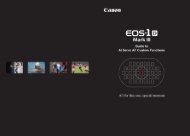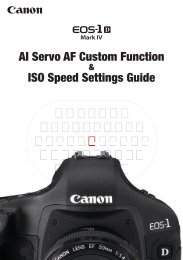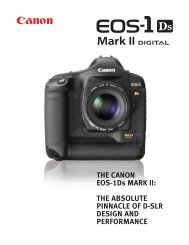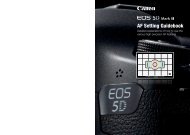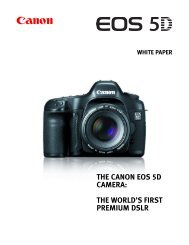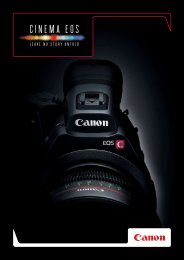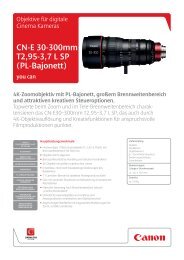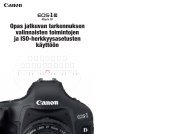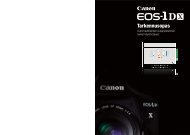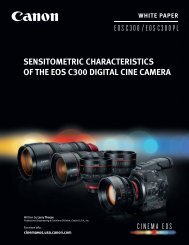THE CANON Eos-1ds MARK III CAMERA: EOS REBORN
THE CANON Eos-1ds MARK III CAMERA: EOS REBORN
THE CANON Eos-1ds MARK III CAMERA: EOS REBORN
Create successful ePaper yourself
Turn your PDF publications into a flip-book with our unique Google optimized e-Paper software.
IX. CONCLUSION<br />
When it was introduced, Canon, with complete justification, called the <strong>EOS</strong>-1Ds Mark II<br />
“The Absolute Pinnacle of DSLR Design and Performance.” Now the pinnacle has been<br />
raised. Technological advances have continued to come at a furious rate, even as the<br />
digital age of photography has matured, and it should surprise no one that Canon is<br />
able to build a better flagship than it did a few years ago. Nonetheless, there are many<br />
aspects of the <strong>EOS</strong>-1Ds Mark <strong>III</strong> that are astonishing. For example, the 16.7-megapixel,<br />
4 fps <strong>EOS</strong>-1Ds Mark II it succeeds is still the leader in its class. On the same full-size<br />
sensor plate, Canon now has 21.1 megapixels that, although they are smaller than<br />
those of the <strong>EOS</strong>-1Ds Mark II, record a finer image with 14-bit depth and vastly greater<br />
control possibilities. At 5 fps, the <strong>EOS</strong>-1Ds Mark <strong>III</strong> fires off its enormous image files as<br />
fast as most 10 megapixel cameras can make 12-bit files. This is one camera that can<br />
excel in studios, sporting venues, and the farthest and most remote reaches of the<br />
earth. Its files can generate prints and magazine layouts equally remarkable for their<br />
great size and superlative quality. No other camera can make such a claim credibly.<br />
Viewed in terms of its resolution alone, the <strong>EOS</strong>-1Ds Mark <strong>III</strong> seems to compete with the<br />
medium format digital backs that cost somewhere between more and much more. At<br />
this point, many even have less resolution than the <strong>EOS</strong>-1Ds Mark <strong>III</strong>. But their cumbersome<br />
handling and their very limited and expensive systems, especially in comparison<br />
with the Canon <strong>EOS</strong> System, mean that they are capable of functioning in just a very<br />
small portion of all the photographic situations in which the <strong>EOS</strong>-1Ds Mark <strong>III</strong> excels.<br />
Consider, too, the question of continuity, a matter of considerable relevance when the<br />
purchase of an $8,000-or- more camera is on the table. Where the <strong>EOS</strong>-1Ds Mark <strong>III</strong> is<br />
completely compatible with virtually all of the vast <strong>EOS</strong> System, and can be expected to<br />
remain compatible—and supported—for decades to come (note the current software<br />
support for the D6000 and D2000), today’s medium format digital backs often do not fit<br />
even recent products from the same manufacturer. Will a newly-purchased component<br />
be compatible with same-brand software and hardware in the not-too-distant future?<br />
Betting on, and investing in, the <strong>EOS</strong>-1Ds Mark <strong>III</strong> is a sure thing.<br />
When Canon shows a diagram of its DSLR family, it has co-equals at the top of the<br />
range, the <strong>EOS</strong>-1D Mark <strong>III</strong> with a 1.3x sensor, 10.1 megapixels and a breathtaking 10<br />
fps, matched with the <strong>EOS</strong>-1Ds Mark <strong>III</strong>, with its full-frame sensor, 21.1 amazing<br />
megapixels and a not-to-be-believed 5 fps for that file size. Both have Live View<br />
Function, the Self Cleaning Sensor Unit, the endless control and customization options,<br />
the high ISOs and low noise and the super-rugged construction. Both epitomize professional<br />
hardware. Choosing between them is really a matter of degree. Both have extraor-<br />
IX. CONCLUSION 37




